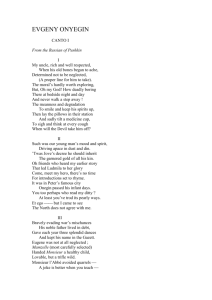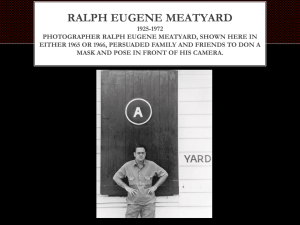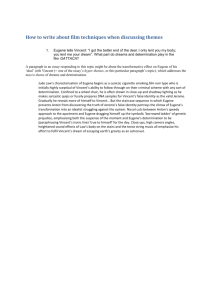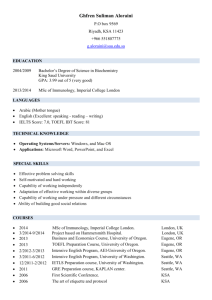The Problem - Barb Snow`s Home Page
advertisement
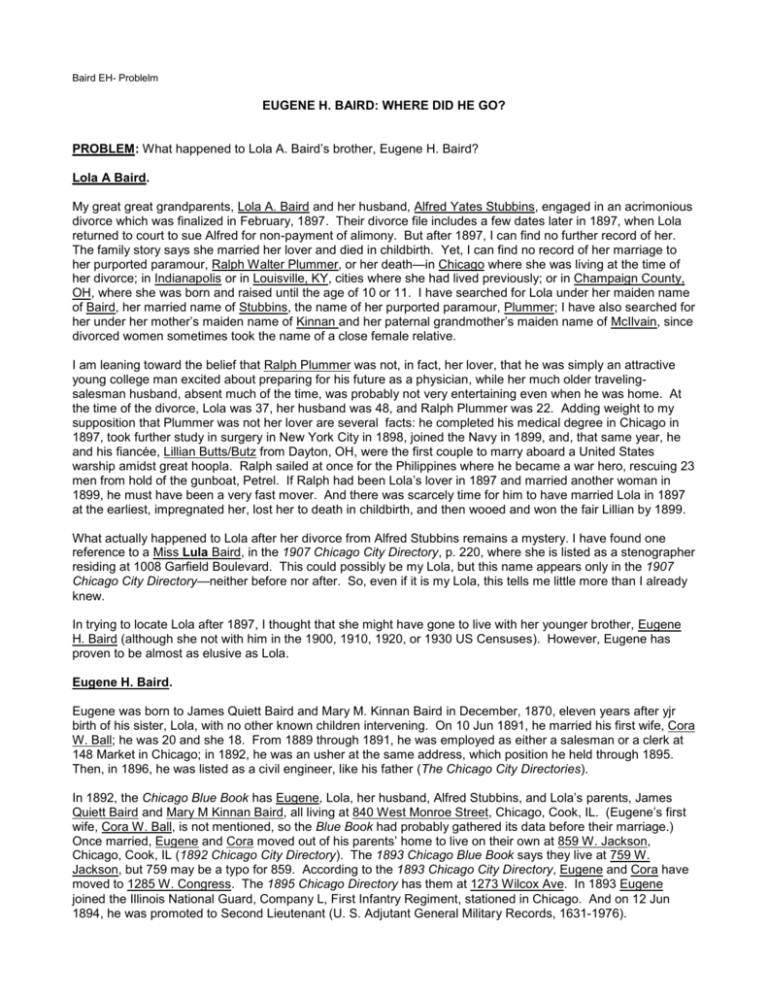
Baird EH- Problelm EUGENE H. BAIRD: WHERE DID HE GO? PROBLEM: What happened to Lola A. Baird’s brother, Eugene H. Baird? Lola A Baird. My great great grandparents, Lola A. Baird and her husband, Alfred Yates Stubbins, engaged in an acrimonious divorce which was finalized in February, 1897. Their divorce file includes a few dates later in 1897, when Lola returned to court to sue Alfred for non-payment of alimony. But after 1897, I can find no further record of her. The family story says she married her lover and died in childbirth. Yet, I can find no record of her marriage to her purported paramour, Ralph Walter Plummer, or her death—in Chicago where she was living at the time of her divorce; in Indianapolis or in Louisville, KY, cities where she had lived previously; or in Champaign County, OH, where she was born and raised until the age of 10 or 11. I have searched for Lola under her maiden name of Baird, her married name of Stubbins, the name of her purported paramour, Plummer; I have also searched for her under her mother’s maiden name of Kinnan and her paternal grandmother’s maiden name of McIlvain, since divorced women sometimes took the name of a close female relative. I am leaning toward the belief that Ralph Plummer was not, in fact, her lover, that he was simply an attractive young college man excited about preparing for his future as a physician, while her much older travelingsalesman husband, absent much of the time, was probably not very entertaining even when he was home. At the time of the divorce, Lola was 37, her husband was 48, and Ralph Plummer was 22. Adding weight to my supposition that Plummer was not her lover are several facts: he completed his medical degree in Chicago in 1897, took further study in surgery in New York City in 1898, joined the Navy in 1899, and, that same year, he and his fiancée, Lillian Butts/Butz from Dayton, OH, were the first couple to marry aboard a United States warship amidst great hoopla. Ralph sailed at once for the Philippines where he became a war hero, rescuing 23 men from hold of the gunboat, Petrel. If Ralph had been Lola’s lover in 1897 and married another woman in 1899, he must have been a very fast mover. And there was scarcely time for him to have married Lola in 1897 at the earliest, impregnated her, lost her to death in childbirth, and then wooed and won the fair Lillian by 1899. What actually happened to Lola after her divorce from Alfred Stubbins remains a mystery. I have found one reference to a Miss Lula Baird, in the 1907 Chicago City Directory, p. 220, where she is listed as a stenographer residing at 1008 Garfield Boulevard. This could possibly be my Lola, but this name appears only in the 1907 Chicago City Directory—neither before nor after. So, even if it is my Lola, this tells me little more than I already knew. In trying to locate Lola after 1897, I thought that she might have gone to live with her younger brother, Eugene H. Baird (although she not with him in the 1900, 1910, 1920, or 1930 US Censuses). However, Eugene has proven to be almost as elusive as Lola. Eugene H. Baird. Eugene was born to James Quiett Baird and Mary M. Kinnan Baird in December, 1870, eleven years after yjr birth of his sister, Lola, with no other known children intervening. On 10 Jun 1891, he married his first wife, Cora W. Ball; he was 20 and she 18. From 1889 through 1891, he was employed as either a salesman or a clerk at 148 Market in Chicago; in 1892, he was an usher at the same address, which position he held through 1895. Then, in 1896, he was listed as a civil engineer, like his father (The Chicago City Directories). In 1892, the Chicago Blue Book has Eugene, Lola, her husband, Alfred Stubbins, and Lola’s parents, James Quiett Baird and Mary M Kinnan Baird, all living at 840 West Monroe Street, Chicago, Cook, IL. (Eugene’s first wife, Cora W. Ball, is not mentioned, so the Blue Book had probably gathered its data before their marriage.) Once married, Eugene and Cora moved out of his parents’ home to live on their own at 859 W. Jackson, Chicago, Cook, IL (1892 Chicago City Directory). The 1893 Chicago Blue Book says they live at 759 W. Jackson, but 759 may be a typo for 859. According to the 1893 Chicago City Directory, Eugene and Cora have moved to 1285 W. Congress. The 1895 Chicago Directory has them at 1273 Wilcox Ave. In 1893 Eugene joined the Illinois National Guard, Company L, First Infantry Regiment, stationed in Chicago. And on 12 Jun 1894, he was promoted to Second Lieutenant (U. S. Adjutant General Military Records, 1631-1976). 2 Interestingly, Eugene and Cora seem to have begun to have marital difficulties about the same time as Lola and Alfred. Eugene and Cora may have begun the year 1895 together. They are listed together in the 1895 Chicago Blue Book as living at 579 Jackson Boulevard, but they were probably divorced that year. The 1896 edition of the Chicago Blue Books is unavailable online, but neither Eugene not Cora is listed there in subsequent years. (After Lola’s and Alfred’s scandalous divorce, not only they, but also Lola’s parents were also quietly dropped from the pages of the Chicago Blue Books.) By 1896, Eugene and Cora are living at separate addresses and no doubt divorced: Cora has moved to 780 W. Jackson Boulevard, and Eugene has moved back home with his parents at 1149 Jackson Boulevard (1896 Chicago City Directory). Interestingly, Cora lists herself as the widow of Eugene H., rather than as a divorcée (although Eugene is very much alive— and just a few lines down in the Directory), presumably because divorce was still considered very shameful. About this time, Eugene seems to have been also making a career change: in addition to his divorce, he also resigned from the Illinois National Guard on 2 Oct 1895. In 1895 he was a clerk at 148 Market Street in Chicago (1895 Chicago City Directory), but in the 1896 Directory, he was living back with his parents and had apparently joined his father’s firm, the Chicago Surveying and Engineering Company, at 40,155 Washington, Chicago as a civil engineer. This suggests that James Q. Baird must have taken Eugene’s side in his divorce, because, in the divorce of James’s daughter, Lola’s divorce, her father evicted her from his home yet invited her ex-husband, Alfred Stubbins, to continue to live with the family. In 1897, Eugene is still working for and living with his father, but he disappears from the 1998 and 1999 Chicago City Directories. In the 1899 Directory, James Q. Baird has moved to 350 Park Ave. in Chicago, and, in the 1900 US Census, Eugene is back at his father’s new address, 350 Park Ave. working as a civil engineer. In 1901, Eugene is still living in his father’s home and working as a surveyor. [Engineers also functioned as surveyors.] 1902, Eugene does not appear in either the Chicago or the Grand Rapids City Directory, and we must wonder where he was. In an article in the Grand Rapids Press on 24 Oct 1906, discussing the fifty-second wedding anniversary of the elder Bairds, it states: “Eugene H. Baird [,] was Deputy Kent county surveyor up to two years ago [1904] when he went to Paris, Ill., where he now resides.” The reporter seems to have the dates confused, but Paris, IL may have been where Eugene was living in 1902. Could he possibly have gone to Paris, IL because that was where his sister, Lola Baird Stubbins, was living after her parents exile her? Unfortunately, the extant Paris City Directories begin in 1904 and are not available online, but they are available in the Allen County Public Library. In 1903, the elder Baird moved the remainder of his family to Grand Rapids, Kent, Michigan. But, on 6 May 1903, Eugene is also in Grand Rapids, working as the Deputy Kent County Surveyor and marrying his second wife, Gertrude E. Dalzell, stenographer to the Deputy County Surveyor (1904 Grand Rapids City Directory). Now we must wonder whether he married his secretary or whether he gave his new wife a job in his office? Problem: He continued to hold that position in 1904, according to the Grand Rapids City Directory from that year. But whatever the connection between Eugene and Paris, IL, in 1904, he is in Grand Rapids, working as a civil engineer, but not in his former county position. He and Gertrude are living at 13 Park Avenue—apart from his parents—and he works as a civil engineer from his residence. In 1909, he is still working from his home at 87 Ransom as a civil engineer. The Grand Rapids City Directory says he rooms there, and we must assume Gertrude and he are still a couple. But the next year, in 1910, Eugene and Gertrude make a big move. The US Census tells us that Eugene is the foreman on a railroad construction crew in Council Bluffs, Kane Twp., Pottawattamie, Iowa, and apparently resides there with Gertrude in the 8th Street Construction Camp. It is at this time, I believe, that he was first hired by the C, B, and Q Railroad Company [Chicago, Burlington and Quincy] as a railroad construction engineer & concrete bridge builder, a position he seems to have kept at least until 1930, the last time I have found any record of him. His residences from 1910-1930 all correspond to the routes of the C, B, & Q Railroad Company as they spread their service out westward from Chicago. The first actual mention of his association with the C, B, & Q Railroad, however, is in an article on his parents’ 60th wedding anniversary in the Grand Rapids Press, 23 Oct 1914. It is mentioned again in an article in the Detroit Free Press two years later, 24 Oct 1916, on the occasion of the old couple’s 62nd wedding anniversary. It appears his parents were still proud enough of their son to mention him to the reporters—even though he had been divorced and remarried—yet, they refused ever to utter the name of their daughter, Lola, following her divorce. 3 In 1917, Eugene placed a want ad in the Omaha World Herald (Omaha, NE), seeking bridge carpenters and laborers who should reply to him in Casper, Natrona, Wyoming, where he must have been living. Perhaps Omaha was to be the next city to receive an extension of the C, B, & Q Railroad. Maybe the frequent moves to frontier towns around the country were getting to Gertrude, maybe she thought Eugene was too wrapped up in his work with not enough time for her, maybe he was a womanizer, or maybe he was just hard to get along with. Whatever her reasons, on 30 Jun 1919, she was granted a default divorce from Eugene in Basin, Big Horn, Wyoming, according to The Basin Republican; The Big Horn Basin Booster (04 Jul 1919). Basin was the county seat of Big Horn County, and so it was probably not the residence of either, but simply the city where divorce cases were heard. It seems significant that Eugene’s divorce took place two and a half months after the death of Eugene’s father, James Q. Baird, at age 89. Could Eugene have put off the divorce until after his father’s death so that the old man would not revile him as he had Eugene’s sister, Lola? After the divorce, Gertrude set herself up as the landlady of the Greybull Hotel in Greybull Big Horn, Wyoming. In the 1920 US Census, she is head of household, rents, and has two male roomers. She calls herself a widow, as Eugene’s first wife, Cora, did, although both were divorcées. Eugene is not in the 1920 US Census for some reason, but a newspaper article tells us he was living in Worland, Washakie, Wyoming, and immersing himself in the life of the town. On 25 May 1920, the article in the Wyoming State Tribune (Cheyenne, WY) about a state-wide meeting of the Masons tells us that Eugene was an active member of the Freemasons, Scottish Rite. So immersed in the life of the town was Eugene that he married a third time the next year. On 3 Sep 1921, he weds Mrs. Ada Ainsworth. Their marriage license is very informative: they were both divorced, their parents are named, although it looks like Eugene forgot his father’s first name: James Q. Baird became John Q. Baird. Mrs. Ainsworth’s parents were Thomas Jubb and Sarah Cahill. But, even more interesting than that is the fact that Eugene cuts five years off his age: instead of his true age of 50, he says he is 45. But that is understandable when we read that dear Ada, already divorced, was only 21! It is likely that Ada’s father was younger than Eugene. In the obituary of his mother, Mary M. Kinnan Baird, in the Grand Rapids Press, published 18 Mar 1922, we learn that Eugene (and presumably Ada) is living in Greybull, Big Horn, Wyoming. The next source I have is the 1930 US Census which has the couple—still married after about 9 years!—living in Leota Twp., Norton, Kansas, a township which seems to be on one of the C, B, & Q’s tracks. They are renting and own a radio. He apparently lied about his age to Ada, because he is still deducting five years. He is actually 60 but says he’s 55, and Ada is only 30. Eugene is most likely still with C, B, & Q Railroad Company, because his occupation is Foreman of a Bridge Gang (which the transcriber gave as “Farmer of a Bridge Gong.” If I hadn’t know his occupation, I would never have thought this my “my” Eugene. And that’s the last bit of information I have been able to find on Eugene H. Baird. It’s pretty clear that Lola did not take refuge with Eugene—unless he was helping her during that missing year of 1902—unless she (and he) had been in Paris, Illinois that year. Perhaps that’s where she died. And the dadblamed Paris City Directories start in 1904. I’ve got to check out the newspapers from Paris again.

